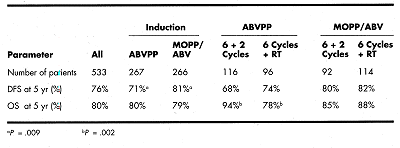Radiotherapy Versis Chemotherapy as ConsolidativeTreatment for Stage IIIB-IV Hodgkin’s Disease in First Complete Remission or Good Partial Response: A Study of 559 Patients (H89 Protocol)
The role of radiotherapy in combination with chemotherapy in advanced-stage Hodgkin’s disease remains controversial.
The role of radiotherapy in combination with chemotherapy in advanced-stage Hodgkin’s disease remains controversial. Between July 1989 and December 1996, 559 patients less than 66 years of age with stage IIIB-IV previously untreated Hodgkin’s disease were randomized, at diagnosis, to receive six cycles of ABVPP (Adriamycin, bleomycin, vinblastine, procarbazine, and prednisone; group A) or a MOPP/ABV (mechlorethamine, Oncovin, procarbazine, and prednisone/Adriamycin, bleomycin, and vinblastine) hybrid (group B).
Patients in complete remission (CR) or partial remission (PR) ³ 75% after six cycles were then randomized to receive either two additional cycles of the same regimen or radiation therapy: (sub)total nodal irradiation (30 Gy + 5 Gy) to initially involved areas + 5 Gy to the residual mass. Patients not in CR or PR ³ 75% after four to six cycles received intensive salvage therapy with the MINE regimen (mitoguazone, ifosfamide, Navelbine, and etoposide) followed by BEAM (BCNU, etoposide, Ara-C, and melphalan) and autologous bone marrow or peripheral blood stem-cell transplantation.
The analysis was performed on an intention-to-treat basis. Histologic review was achieved in 91% of patients at the date of analysis, and 533 patients were eligible.
Patient characteristics did not differ between the treatment groups: age (median, 32 years), stage (III = 40%; IV = 60%), tumoral mass >10 cm (24%), MT ratio (mass/transverse diameter of the thorax) > 0.45 (9%), bone marrow involvement (20%), number of extranodal sites ³ 2 (27%), anemia (29%), lactic dehydrogenase (LDH) > 1 N (44%).
The CR + PR ³ 75% rate after four cycles was 85% (group A, 85%; group B, 85%) and after six cycles was 86% (group A, 88%; group B, 85%).
A total of 418 patients in CR or PR ³ 75% were randomized to receive consolidative chemotherapy (208 patients) or radiotherapy (210 patients). At a median follow-up of 46 months (range, 8-109 months), 152 patients (28%) had progressed and 90 had died, 43 of Hodgkin’s disease and 47 due to other causes, including solid tumors (7 patients), non-Hodgkin’s lymphoma (NHL; 5 patients), and acute myelocytic leukemia (AML; 1 patient). Three other patients developed secondary AML and are alive without Hodgkin’s disease.
Disease-free survival (DFS) and overall survival (OS) rates were: Cox regression analysis, including the variables of the international prognostic score for advanced Hodgkin’s disease and consolidative treatment, showed a qualitative interaction between induction regimen and consolidative treatment for OS. After ABVPP and radiotherapy, the risk of death was higher than after chemotherapy (relative risk [RR], 4.37; P = .01). After MOPP/ABV, the benefit of radiotherapy was not significant.

CONCLUSION: These results suggest a role of the induction regimen in tumor control. Chemotherapy alone allows the same or a better survival as chemotherapy plus radiotherapy. A longer follow-up and the analysis of fatal events and of salvage from relapse after radiation therapy will be required to arrive at a definitive conclusion.
Click here for Dr. Bruce Cheson’s commentary on this abstract.
Highlighting Insights From the Marginal Zone Lymphoma Workshop
Clinicians outline the significance of the MZL Workshop, where a gathering of international experts in the field discussed updates in the disease state.